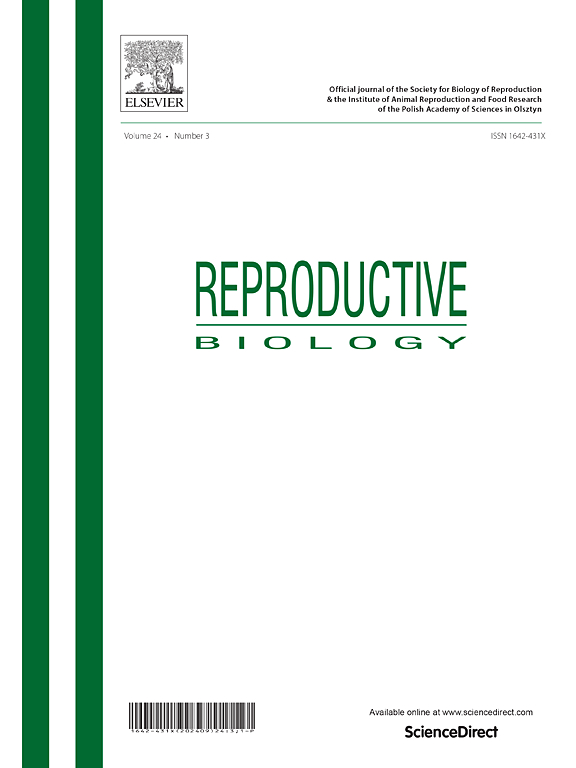Vitamin D3 and insulin treatment affects porcine follicular fluid-derived extracellular vesicles characteristics and proteome cargo
IF 2.5
3区 生物学
Q3 REPRODUCTIVE BIOLOGY
引用次数: 0
Abstract
The study aimed to investigate whether vitamin D3 and insulin alone or in co-treatment can influence characteristics and protein cargo of the porcine follicular fluid (FF)-derived extracellular vesicles (EVs). To this end, medium antral follicles were cultured in vitro alone (C; control) or with 1α,25(OH)2D3 (VD; 100 ng/mL) and insulin (I; 10 ng/mL) separately or in combination (VD+I). The properties of the FF-EVs were assessed by transmission electron microscopy, nanoparticle tracking analysis, electroforetic light scattering, and flow cytometry, while the global proteomic analysis was conducted by liquid chromatography-tandem mass spectrometry coupled with the TMT-isobaric mass tag labeling. In all groups, particles represented a typical cup-shaped morphology, ranged between 50 and 450 nm in diameter, and expressed marker proteins, such as CD63 and CD81. The I treatment decreased the concentration and average size of the FF-EVs, while VD reversed only the effect on the particle concentration. Proteomic analysis revealed 48 differentially abundant proteins (DAPs) between examined groups, whilst greater amount of DAPs was identified following VD and I treatment alone than in co-treatment. Functional analysis showed that VD alone or in combination with I decreased predominantly the abundance of ribosomal proteins. In the I group, proteins involved in oxidative stress were down-regulated. We also found that the FF-EVs are carriers of adiponectin, which was up-regulated in the VD+I group. To sum up, VD and I seem to be novel modulators of the porcine FF-EVs characteristics and protein cargo, and thereby could modify ovarian follicle function via the EV-mediated pathway.
维生素D3和胰岛素处理影响猪卵泡液来源的细胞外囊泡特性和蛋白质组货量
本研究旨在探讨维生素D3和胰岛素单独或共同处理是否会影响猪卵泡液(FF)来源的细胞外囊泡(EVs)的特性和蛋白质运输量。为此,体外单独培养中等的窦卵泡(C;对照)或1α,25(OH)2D3 (VD;100 ng/mL)和胰岛素(I;10 ng/mL)单独或组合(VD+I)。通过透射电子显微镜、纳米颗粒跟踪分析、电光散射和流式细胞术对ff - ev的性质进行了评估,并通过液相色谱-串联质谱联用tmt -等压质量标签进行了整体蛋白质组学分析。在所有组中,颗粒呈典型的杯状形态,直径在50到450 nm之间,并表达标记蛋白,如CD63和CD81。I处理降低了ff - ev的浓度和平均大小,而VD只对颗粒浓度有逆转作用。蛋白质组学分析显示,在检查组之间有48种差异丰富的蛋白质(DAPs),而VD和I单独处理后的DAPs数量比共同处理时更多。功能分析表明,VD单独或与I联合主要降低核糖体蛋白的丰度。在I组中,参与氧化应激的蛋白质被下调。我们还发现ff - ev是脂联素的载体,脂联素在VD+I组中上调。综上所述,VD和I似乎是猪ff - ev特性和蛋白质货物的新型调节剂,因此可以通过ev介导的途径改变卵巢卵泡功能。
本文章由计算机程序翻译,如有差异,请以英文原文为准。
求助全文
约1分钟内获得全文
求助全文
来源期刊

Reproductive biology
生物-生殖生物学
CiteScore
3.90
自引率
0.00%
发文量
95
审稿时长
29 days
期刊介绍:
An official journal of the Society for Biology of Reproduction and the Institute of Animal Reproduction and Food Research of Polish Academy of Sciences in Olsztyn, Poland.
Reproductive Biology is an international, peer-reviewed journal covering all aspects of reproduction in vertebrates. The journal invites original research papers, short communications, review articles and commentaries dealing with reproductive physiology, endocrinology, immunology, molecular and cellular biology, receptor studies, animal breeding as well as andrology, embryology, infertility, assisted reproduction and contraception. Papers from both basic and clinical research will be considered.
 求助内容:
求助内容: 应助结果提醒方式:
应助结果提醒方式:


